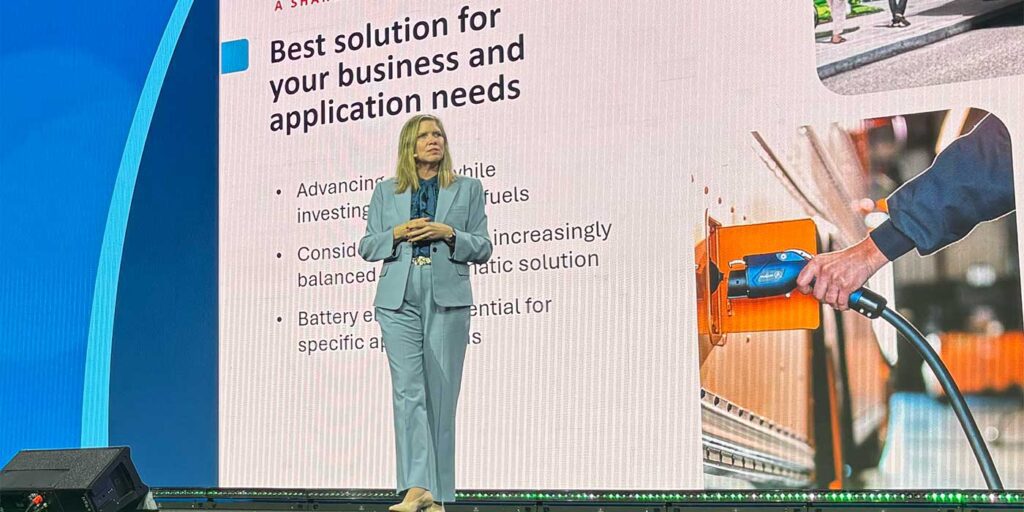The journey towards a sustainable future in trucking is not straightforward; it’s a complex and evolving process. This was the gist of Jennifer Rumsey’s remarks, Chair and CEO of Cummins Inc., regarding the current state of the energy transition in trucking during her recent address at ACT Expo 2025. For managers of heavy-duty truck equipment, grasping the changing landscape of various truck powertrain technologies is pivotal as the industry moves forward.
The Necessity for Diverse Truck Powertrain Technologies
Rumsey underscored that the industry has transformed significantly in just a year, with rapid changes in regulations, incentives, and trade policies. While the aim of achieving net-zero emissions persists, the path is now more multifaceted, requiring investments in various power technologies instead of a singular focus.
Due to regulatory unpredictability, Cummins continues to allocate billions toward new technologies. According to Rumsey, relying solely on one type of powertrain or emission standard is inadequate. The future must embrace advanced diesel, natural gas, biodiesel, hydrogen engines, battery-electric systems, fuel cells, and hybrid solutions.
The Significance of Lifecycle Emissions
Rumsey also highlighted that sustainability initiatives should consider lifecycle emissions rather than just exhaust emissions. This approach involves assessing the environmental effects of fuel production, transport, and distribution. “By adopting a broader lifecycle perspective,” she stated, “we can ensure policies reflect the true ecological impacts of various fuels.”
Fleets like PepsiCo are already exploring this comprehensive view by testing multiple technologies, such as battery-electric and biodiesel, to decrease their overall carbon emissions. For truck equipment managers, this emphasizes the necessity of evaluating not just vehicle emissions but also the complete impact of fuel and energy selections.
The Continuing Importance of Diesel Engines
Even with the industry’s shift towards electrification, diesel engines still play a substantial role in reducing carbon emissions. In the past 25 years, improvements in fuel injection, turbocharging, aftertreatment technologies, and controls have slashed diesel particulate emissions by over 98% in the U.S. Currently, it takes 60 modern Class 8 trucks to produce the same amount of emissions as a single truck from 1988.
Cummins has also increased the fuel efficiency of its highway heavy-duty engines by nearly 25% since 2010, resulting in significant savings and environmental advantages. The company is on track to meet its goal of cutting down 55 million metric tons of greenhouse gases from existing products by 2030—equating to a reduction of 5.4 billion gallons of diesel.
Advancements in Hybrid and Battery Electric Technologies
While diesel technology continues to advance, hybrid and battery-electric solutions are gaining momentum. Hybrids serve as a viable intermediary solution, addressing limitations in range and fuel efficiency while also contributing to decreased battery costs at a larger scale.
Rumsey mentioned that insights gained from the automotive industry’s hybrid experiences are being harnessed in commercial trucking. Battery-electric technologies are becoming more practical as lithium-ion battery prices have plummeted by 85% over the past decade. Cummins’ collaboration with PACCAR North America to produce lithium iron phosphate battery cells in the U.S. is crucial for boosting electrification infrastructure in commercial vehicles.
Collaborating for a Sustainable Future
Despite market volatility and uncertainty, Rumsey conveyed a message filled with hope and proactive measures. She emphasized three foundational principles industry leaders and equipment managers must support:
- Fair, achievable regulations that encourage innovation across diverse technologies.
- Lifecycle-based emissions standards that accurately gauge environmental impacts.
- Ongoing innovations aimed at enhancing fuel efficiency and providing cost-effective options for fleets.
“Together, we can forge a future that is advantageous for businesses, the economy, and the environment while ensuring the longevity of our industry,” Rumsey concluded. The key takeaway for truck equipment managers is clear: no single technology will dictate the future. Success lies in adopting a diverse approach—capitalizing on diesel advancements, experimenting with hybrids and electric vehicles as appropriate, and considering total lifecycle emissions. This strategy will not only meet immediate operational demands but also contribute to a more sustainable future.


